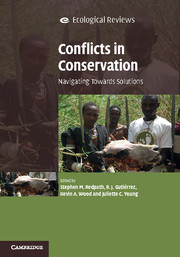Book contents
- Frontmatter
- Dedication
- Contents
- List of contributors
- Foreword by Georgina Mace
- Acknowledgements
- Part I Introduction to conservation and conflict
- PART II Contrasting disciplinary approaches to the study of conflict in conservation
- 3 The value of ecological information in conservation conflict
- 4 Environmental history and conservation conflicts
- 5 The political ecology of conservation conflicts
- 6 Understanding conservation conflicts: an economic perspective
- 7 Anthropological approaches to conservation conflicts
- 8 Law and conservation conflicts
- 9 The relevance of psychology to conservation conflicts
- 10 Conservation conflicts: ethical issues
- 11 A view from sociology: environmental movement mobilisation over old-growth temperate rainforests in British Columbia
- 12 Peace research and conservation conflicts
- 13 Linking conflict and global biodiversity conservation policies
- Part III Approaches to managing conflicts
- Index
- Plate Section
- References
3 - The value of ecological information in conservation conflict
from PART II - Contrasting disciplinary approaches to the study of conflict in conservation
Published online by Cambridge University Press: 05 May 2015
- Frontmatter
- Dedication
- Contents
- List of contributors
- Foreword by Georgina Mace
- Acknowledgements
- Part I Introduction to conservation and conflict
- PART II Contrasting disciplinary approaches to the study of conflict in conservation
- 3 The value of ecological information in conservation conflict
- 4 Environmental history and conservation conflicts
- 5 The political ecology of conservation conflicts
- 6 Understanding conservation conflicts: an economic perspective
- 7 Anthropological approaches to conservation conflicts
- 8 Law and conservation conflicts
- 9 The relevance of psychology to conservation conflicts
- 10 Conservation conflicts: ethical issues
- 11 A view from sociology: environmental movement mobilisation over old-growth temperate rainforests in British Columbia
- 12 Peace research and conservation conflicts
- 13 Linking conflict and global biodiversity conservation policies
- Part III Approaches to managing conflicts
- Index
- Plate Section
- References
Summary
The British countryside is renowned for its pastoral beauty: a rich mosaic of farmland, woodlands, hedgerows and winding lanes where biodiversity flourishes. Yet linger within this apparently serene landscape and you are likely to discover an equally rich mosaic of conflict, which can sometimes be bitter and acrimonious. We see conflicts emerge over a wide range of issues, such as the culling of badgers Meles meles to control disease in cattle, the impact of intensive farming techniques on biodiversity or the illegal killing of predators for the benefit of game species. As we see elsewhere in this book, such conflicts are not restricted to the UK; they occur worldwide. Conflicts differ in details and participants, but they are often similar in challenges and strategies for resolution.
Ecological arguments invariably are part of conservation conflicts. We need to understand what impacts our activities have on species and ecosystems. Typically, in conflicts, the information deficit model is followed (Burgess et al., 1998). This model holds that more expert knowledge (in our case ecological data) and better communication are needed to help raise awareness, develop effective policies and change people's behaviour. Ecology is therefore often seen as providing the necessary objective evidence to enable decisions to be made to address conservation conflict. Consider, for example, the situation of conflicts involving predators. Those whose livelihoods depend on prey species commonly perceive predators as threats. So, ecologists commonly ask if perceptions of impact match ecological data (Sillero-Zubiri et al., 2007; Dickman, 2010). To make a decision about predator management, we need to quantify predation levels, understand how predation varies in time and space and how predators impact prey populations. Once we understand these ecological interactions and impacts, we can then make predictions about when and where different interests may become incompatible and to initiate management decisions. Frequently there may be several different techniques available for reducing impact so we need to know the relative effectiveness of each (Smith et al., 2014). Ecological data and analysis can help us distinguish between the effectiveness of alternative management strategies (see Box 9).
- Type
- Chapter
- Information
- Conflicts in ConservationNavigating Towards Solutions, pp. 35 - 48Publisher: Cambridge University PressPrint publication year: 2015
References
- 11
- Cited by



